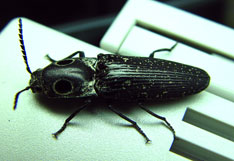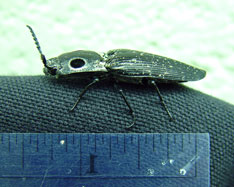Some cool bugs are out and about
Cool Bug Week brought in Cecropia moths, whitespotted pine sawyers, and eyed click beetles. Pine sawyers resemble invasive Asian longhorned beetles, so send lookalikes for ID. Eyed click beetles are harmless predators found in decaying wood.
Editor’s note: This article is from the archives of the MSU Crop Advisory Team Alerts. Check the label of any pesticide referenced to ensure your use is included.
Apparently the week of June 22 is “Cool Bug Week” because we got some dandies in the lab. Jeanne (don’t know her last name) sent me a great photo of a Cecropia moth that she was trying to identify. The Cecropia moth is one of our most spectacular moths. The larvae feed on various broadleaf trees and shrubs. The caterpillar is equally, if not more impressive.
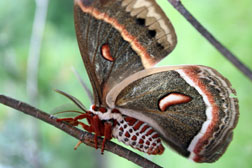
This very nice photo of a Cecropia
moth was sent to us by Jeanne
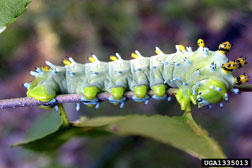
For those of us who prefer the larval
stages of cute bugs, here's what a
Cecropia moth caterpillar looks like.
Photo credit: J. Ghent, USDA Forest Service. Courtesy of
forestryimages.org
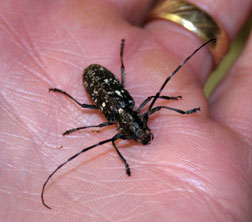
A female whitespotted pine sawyer
beetle. Photo credit: S. Gower, MSU Diagnostic
Services
I got a call from a concerned citizen saying he found Asian longhorned beetles up by Ludington last weekend, which made me think that our native Whitespotted pine sawyer, Monochamus scutellatus beetles have emerged. And sure enough, we got a very nice specimen from Norm Myers, the CED up in Oceana County.
Pine sawyers (Monochamus spp.) are the most common “I-think-I-found-an-Asian-longhorned-beetle” that are sent into the lab and for good reason, the resemblance is striking. See photos of the Asian longhorned beetle to see what I mean. The Asian longhorned beetle is a highly destructive exotic insect that has been in Chicago and New York, nobody here wants to see it in Michigan, so send me anything that even comes close to looking like an Asian longhorned beetle and I would be happy to look at it at, no charge.
The genus Monochamus is represented by several wood-boring beetle species in the eastern United States, all of which feed on various conifers. The most common species in our area are M. scutellatus and the northeastern sawyer, M. notatus. The larvae are known as "sawyers" because of the loud noise they make while feeding. Freshly cut, felled, dying or recently dead trees are preferred. Young larvae feed on the inner bark, cambium and outer sapwood, forming shallow excavations called surface galleries that they fill with coarse, fibrous borings and frass (insect excrement). As they grow older, they bore deep into the heartwood, and then turn around and bore back toward the surface, thereby forming a characteristic U-shaped tunnel. A pupal cell is formed at the outer end of the tunnel, from which the adult emerges by chewing through the remaining wood and bark. Eggs are laid in slits or niches chewed in the bark, preferably near old branch scars or in wrinkled areas on logs. Full-grown larvae are often close to two inches long.
Two years are required to complete the life cycle in the Lake States and southern Canada. Members of the genus often cause heavy losses in wind-thrown or fire-killed timber, in saw logs left too long in the woods or left too long with the bark on before milling, and in improperly handled pulpwood. Adult beetles are vectors of Pinewood nematode.
Norm also sent us an eyed click beetle or eyed elator, Alaus oculatus. This is another very handsome beetle and is our largest member of the click beetle family, Elateridae. Its common name comes from the two large eye-spots on the pronotum. The larvae, which may reach nearly two inches in length, live in moist, decayed wood, especially stumps. The larvae are predaceous on other insects. These handsome beetles are harmless.



 Print
Print Email
Email